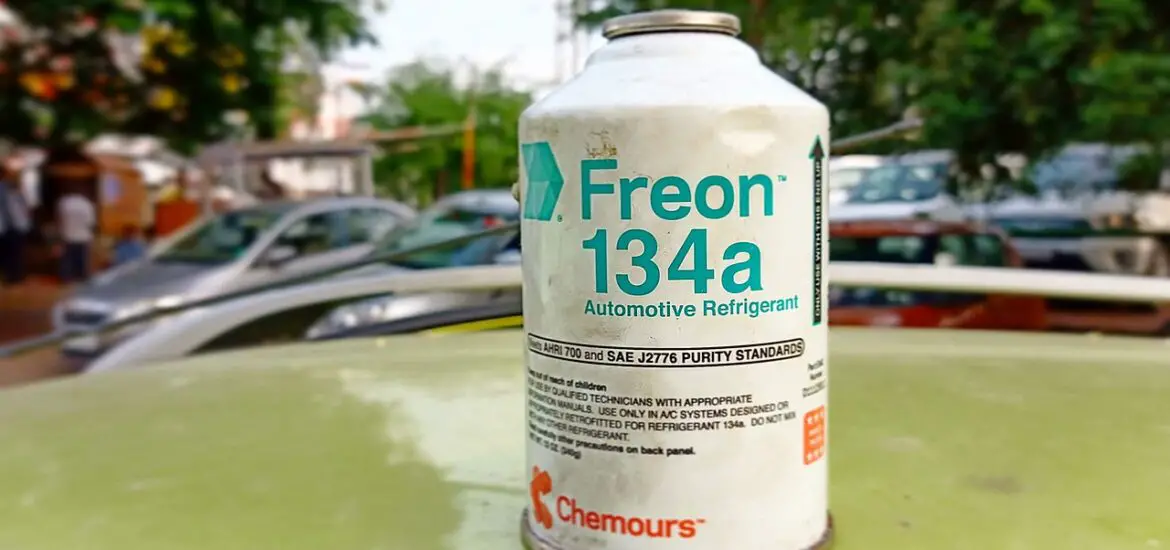Overfilled refrigerant in cars? Yeah, it’s a thing. Too much of a good thing can be harmful, and your car’s refrigerant isn’t an exception. When your car’s refrigerant goes from chill to overkill, it can cause a heap of trouble. Let’s steer clear of that, shall we?

Table of Contents
Identifying Overfilled Refrigerant in Cars
Identifying overfilled refrigerant in your car isn’t rocket science. It’s about knowing the symptoms, having the right tools, and understanding how to check the levels.
Symptoms of Overfilled Refrigerant
What happens when you supercharge your AC with refrigerant? Not a cool party, that’s for sure. You might notice reduced cooling efficiency or the AC might start blowing warm air. Hear any strange noises? That could be another red flag.
Tools Needed for Checking Refrigerant Levels
Before you play detective with your car’s AC, you’re gonna need the right gear. You’ll want a quality AC pressure gauge and protective gloves and glasses. Remember, safety first!
How to Check Refrigerant Levels
Ready to check those levels? Follow these steps: Turn off your car. Locate the AC system’s low-side port and connect your AC gauge. Start your car and let the AC run. Check the gauge reading. Easy peasy, right?
Consequences of Overcharged Refrigerant in Cars
So, what’s the big deal with overfilled refrigerant in cars? Apart from getting less of that cool breeze, there are some serious consequences.
Impact on the Air Conditioning System
Too much refrigerant can make your AC system work overtime, causing efficiency to drop and potentially damaging the compressor. It’s like running a marathon in a heatwave – not cool, literally and figuratively!
Potential Damage to Car Components
Overfilled refrigerant isn’t just bad news for your AC. It can also damage other car components. When the AC compressor fails, it can send debris into the rest of your AC system. You wouldn’t want that, would ya?
Safety Hazards
Remember those protective gloves and glasses? That’s because refrigerant can be dangerous stuff. Overfilling can lead to leaks, which can cause skin and eye irritation, or worse if it’s inhaled. So, let’s avoid going down that road.
Read more detailed articles on refrigerants here – Articles on Refrigerants: The Ultimate Guide to Understanding Them
Solutions for Overfilled Refrigerant in Cars
So, you’ve got an overfilled refrigerant situation. Don’t sweat it, there are solutions.
Professional Servicing
One way to fix overfilled refrigerant is by taking your car to a professional mechanic. They’ve got the knowledge, tools, and safety equipment to sort this out. And it’s always nice to leave the heavy lifting to the pros, right?
DIY Solutions
If you’re the hands-on type, you’ll be happy to hear you can fix an overfilled refrigerant problem yourself. But remember, safety comes first, and we want to keep our planet green. So, don’t release refrigerant into the atmosphere. Let’s get down to it.
Gather Your Tools
First things first, you’re gonna need some tools. Get yourself a refrigerant reclaimer (this is what’ll help you remove and store the excess refrigerant), an AC gauge set, and protective gear. Don’t forget those gloves and glasses!
Set Up Your Gear
Connect the AC gauge set to your car’s AC system. You’ll connect the blue hose to the low-side service port and the red hose to the high-side service port. Make sure the valves on the gauge set are closed before you start.
Connect the Refrigerant Reclaimer
Next, you’ll connect the yellow hose from the AC gauge set to the refrigerant reclaimer. Open the valve on the reclaimer and turn it on. This will start the process of removing the excess refrigerant.
Monitor the Process
Keep an eye on the pressure readings on the AC gauge set. When the pressure in the system matches the recommended levels (check your car’s manual for this), close the valves on the AC gauge set and turn off the reclaimer.
Check Your Work
Start your car and let it run for a few minutes with the AC on. How’s it feeling? Cooler? Congrats, you’ve successfully removed excess refrigerant from your car! If it’s still not cooling as it should, you might want to consider seeking professional help.
Preventing Overfilled Refrigerant in Cars
Prevention is better than cure, and this old adage holds true for dealing with overfilled refrigerant in cars.
Regular Maintenance
Regular maintenance is key. Just like you, your car needs regular check-ups to stay healthy. So, schedule regular AC system inspections to prevent overfilling.
Proper Refrigerant Charging Techniques
When it comes to charging your car’s AC system, more isn’t always better. Follow the manufacturer’s recommendations on how much refrigerant to use. Trust me, your AC will thank you!
Using the Right Tools
Ever tried to hammer a nail with a screwdriver? Using the right tools for the job is crucial. Ensure you’re using a reliable AC pressure gauge to avoid overfilling the refrigerant.
Conclusion
So there you have it, the rundown on overfilled refrigerant in cars. It’s important to keep your car’s refrigerant levels in check to ensure a comfortable, safe, and efficient ride. And remember, when it comes to refrigerant, too much of a good thing can be a real buzzkill!